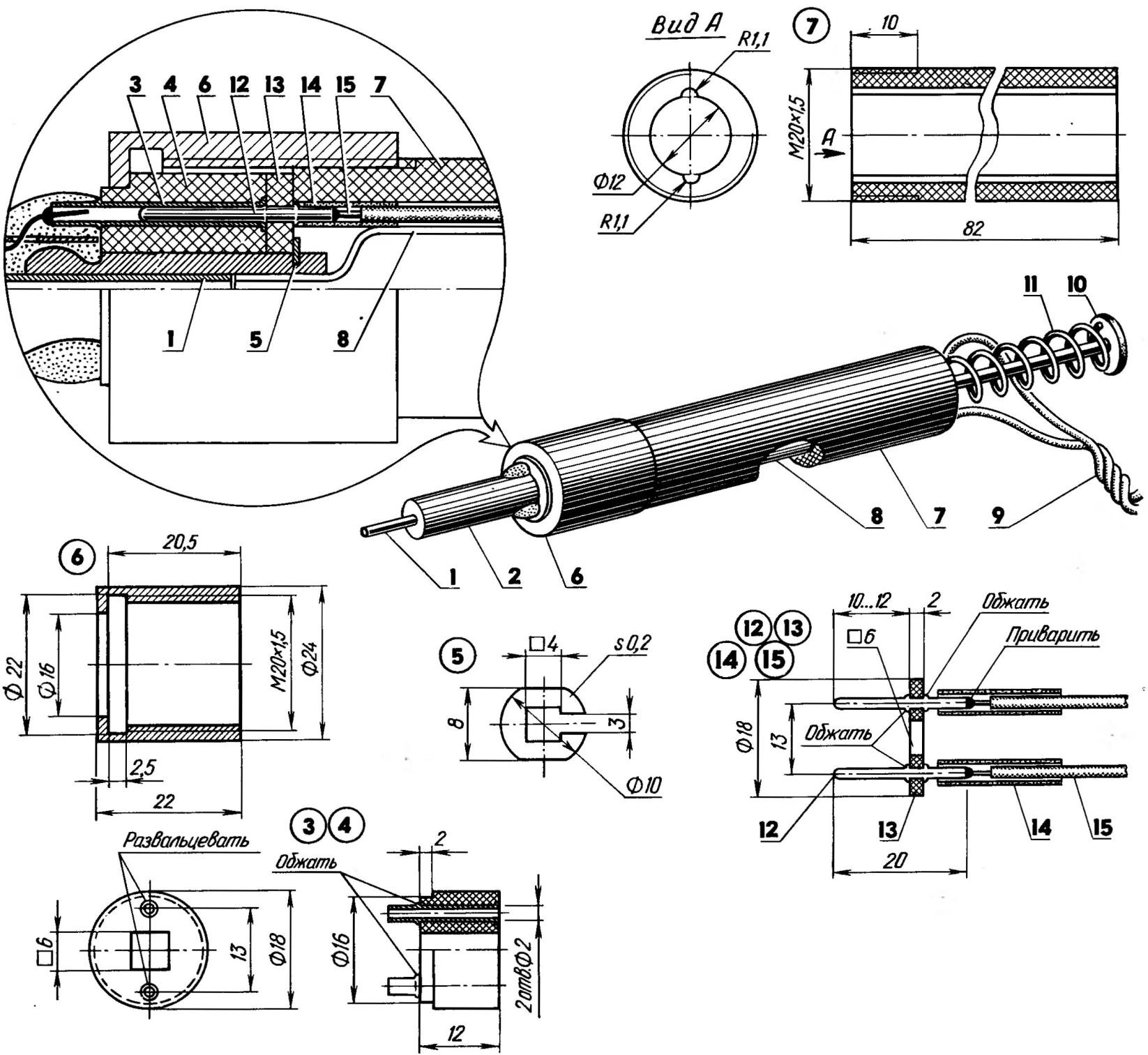
|
|
ENCYCLOPEDIA OF RADIO ELECTRONICS AND ELECTRICAL ENGINEERING Soldering iron from a syringe. Encyclopedia of radio electronics and electrical engineering
Encyclopedia of radio electronics and electrical engineering / Ham Radio Technologies The proposed version of a home-made micro-soldering iron with a built-in desoldering device for desoldering is addressed primarily to radio amateurs and those who have to deal with the installation and removal of microcircuits, as well as low-power semiconductor devices. The basis of the device is ... a medical syringe with a needle, which (after a slight modification) is the working body (Fig. 1). The power consumed by the heating element (again, self-made!), Does not exceed 12 watts. But it is quite enough to bring the temperature of the soldering iron tip to 300 ° C.
At the needle, the former (beveled) end was removed with wire cutters, the edges of the shortened part were slightly turned on an emery bar. At its other landing end, an annular groove is cut for a lock washer, designed to fix the body of the mini-socket (see Fig. 2a). The tip of the microsoldering iron thus obtained is inserted into the copper tube-base of the heating element. Its manufacturing technology is shown in Figure 2 and is not much different from that set out in 6 No. 3 of the magazine "Modeler-Constructor" for 1997. We note only the particulars.
The first insulating layer (from a pasty mixture of office silicate glue and talc in a ratio of 2:1) is applied to the base tube, followed by high-temperature (up to 150°C) drying. Then, a nichrome wire with a diameter of 12 mm is wound 0,2 mm from the edge so that a gap of 0,1-0,2 mm is maintained between the turns. The resulting spiral is rigidly fixed in the wound state, for which one end of it was temporarily passed inside the needle, and the other (short) was fixed outside (at the base) with ordinary threads. A second insulating layer was applied to the resulting workpiece, preventing the appearance of exposed coils, and dried at the same 150°C without swelling of the pasty mass. The long end of the nichrome wire, located in the needle, is brought out and, after 1,5 turns on the already caked coating, is fixed opposite the short end of the spiral, as shown in Figure 2a. And again - the insulating layer, the third in a row. It is applied so that the nichrome leads recessed into the dough-like mass do not touch either the needle or the tube body with two side round cuts (Fig. 26). At the final stage, the body-tube was slightly crimped at the base of the needle and carefully insulated where the future terminal pads for connecting the heating coil to the socket exit through the cutouts (see Fig. 2c). The latter deserves special mention. Its base is made of heat-resistant plastic and has an annular protrusion. The latter is done so that during assembly the nut-cover rests against it with a shoulder, thereby holding the heating element on the body with the syringe in a clamped state The nozzle that keeps the socket from sliding back is made of thin sheet steel. The configuration completely eliminates even accidental electrical contact with sockets rolled into the base of the socket and firmly connected (flattened) to the terminals of the nichrome spiral. So the working tool itself turns out to be removable, and several heating elements can be made - for different diameters of the needle-stings and for any voltage. The manufacture of a housing for a syringe and a plastic nut-cap, as a rule, does not cause difficulties, as well as a mini-fork, which consists of several parts. We only note that the contact rods are two pieces of copper wire, fixed in a washer (made of heat-resistant plastic) with a square central hole. From the side of the syringe, each of the rods is welded (see Fig. 1, pos. 12 and 15) along a conductive core (electric cord tucked into a conventional plug). The main advantage of the soldering iron is the suitability of the design for the dismantling of radio-electronic units and assemblies. All work boils down to the fact that the heated tubular sting moves onto the soldered terminal of the part to be removed (microcircuit or semiconductor device). As practice shows, the solder melts almost instantly and, when the stem of the built-in syringe is pressed, it is simply blown out, exposing both the dismantled lead itself and the micro-area around it. And so that the piston system of the soldering iron does not jam at the same time, it is recommended to lubricate the rubbing parts with glycerin in advance. Authors: A.Naumov, V.Yashin
Artificial leather for touch emulation
15.04.2024 Petgugu Global cat litter
15.04.2024 The attractiveness of caring men
14.04.2024
▪ Mars is poisonous to bacteria ▪ Konica Minolta bizhub C3, C458 and C558 A658 color MFPs ▪ Treatment of infections with electric current
▪ section of the site Radio - for beginners. Article selection ▪ article And everything that he saw before him, he despised or hated. Popular expression ▪ article When did man start making beds? Detailed answer ▪ article Boat knot. Travel Tips ▪ article Electric octopus. physical experiment
Home page | Library | Articles | Website map | Site Reviews www.diagram.com.ua |






 Arabic
Arabic Bengali
Bengali Chinese
Chinese English
English French
French German
German Hebrew
Hebrew Hindi
Hindi Italian
Italian Japanese
Japanese Korean
Korean Malay
Malay Polish
Polish Portuguese
Portuguese Spanish
Spanish Turkish
Turkish Ukrainian
Ukrainian Vietnamese
Vietnamese


 Leave your comment on this article:
Leave your comment on this article: